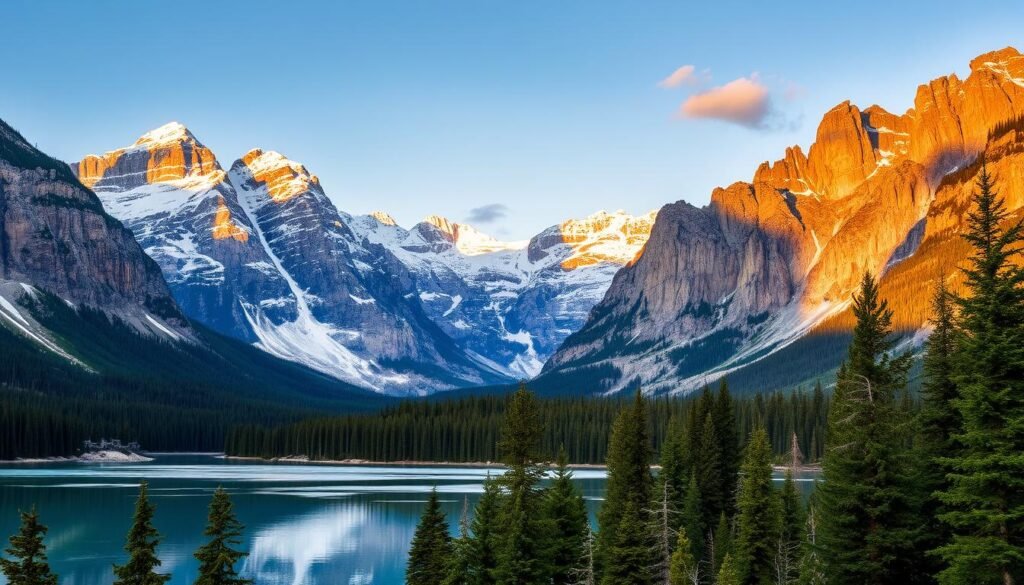Surprising fact: I learned that Banff draws visitors year-round, with winter festivals and turquoise lakes in summer each creating very different magic in the same place.
I’ll walk you through how the canadian rockies shift across the year and why each season feels like a new destination. Snow festivals, reliable ski runs, thawing lakes and larch color all change the list of top activities.
Expectations matter: I explain daylight and weather so you can plan for short cold days in deep winter or long golden evenings in July. I also note crowd and pricing trends so you can pick quieter windows or festive peaks.
I highlight signature spots—Lake Louise, Johnston Canyon, the Banff Gondola and the Icefields Parkway—and show how each shines in different months. There is no single best time to visit banff for everyone; it depends on whether you want powder, paddling, fall color, or festivals.
Key Takeaways
- Banff offers distinct seasonal experiences—snow sports, wildflower hikes, and fall color.
- Weather and daylight shift enough that planning matters for safety and fun.
- Shoulder season often balances lower crowds with good trail access.
- Major attractions look different by month; pick months that match your goals.
- I’ll help match activities and events to the right season for your trip.
Best time to visit Banff at a glance
Here’s a quick snapshot of months that deliver value, access, and pleasant weather for exploring the park. I keep this short so you can plan fast.
Quick answer: I recommend May, June, and September for warm weather, fewer crowds, and better hotel rates in many cases. May brings shoulder season savings and thawing lakes, while September offers great hiking and larch color with lighter crowds.
Winter highlight
March stands out for skiing: days are longer, temperatures soften, and ski areas often see reliable snowfall. If skiing is your main aim, March gives more daylight on the slopes and strong snowpack for powder and groomed runs.
- I flag June as often the wettest of the months—pack a light shell and layers.
- Flexibility pays: shifting your time visit banff by a week can reduce costs and crowds.
- Book early for popular June weekends despite shoulder season pricing spikes.
| Month group | Why pick it | Weather snapshot | Best for |
|---|---|---|---|
| May | Lower rates, thawing trails | Cool mornings, mild afternoons | Wildlife, quieter hikes |
| June | Warm days, wetter spells | Mild with frequent showers | Access to high trails, lakes |
| September | Warm, fewer families | Cool nights, sunny days | Hiking, larch viewing |
If you want deeper planning help, I link a focused guide on the best time visit that matches these windows and offers calendar tips.
Seasons in Banff National Park: What to expect spring through winter
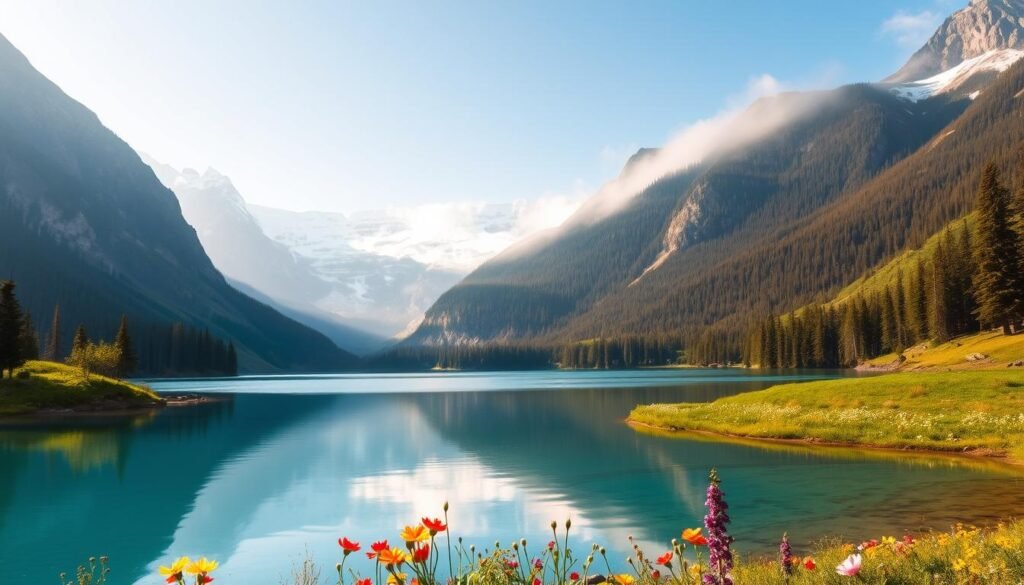
From early melt to deep snow, the park changes fast—here’s what each season will look like on the ground.
Spring (April–May)
Shoulder-season charm: Lower trails often open by April and May. Lakes begin to thaw and wildlife becomes active again.
I note that Open Top Touring returns in mid-April and the Columbia Icefield Adventure opens in May, both offering scenic access before summer crowds arrive.
Summer (June–August)
By late June lakes shift to vivid turquoise and days stretch long. Warm temperatures favor paddling, rafting, and patios in town.
Festivals ramp up—Canada Day in July and Doors Open Banff in August—making summer the most energetic season for visitors.You can learn more about best-places-to-visit-in-spain.
Fall (September–October)
Mid-September to late October brings golden larch trees and cooler temperatures. Trails quiet down and the Banff Centre Film and Book Festival adds culture.
Wildlife activity rises during the elk rut, so mornings and evenings are prime for sightings.
Winter (November–March)
Snow covers the valleys and ski season runs November through May. Expect SnowDays, Ice Magic, Johnston Canyon ice walks, and a festive Gondola at Christmas.
March offers longer daylight with reliable snow—ideal if you want strong ski conditions with more sun.
- Packing tip: Layer for shifting weather and varied temperatures in a single day.
- Timing tip: If you prefer space on trails, aim for shoulder weeks outside peak summer weekends when you plan to visit banff.
Month-by-month guide to visiting Banff
Month-by-month planning clears up how conditions and crowds shift across the year.
January–February
Deep winter: January is coldest with under nine hours of daylight. SnowDays and Ice Magic bring festive events, but some scenic roads close.
February brings about 10 hours of light mid-month and prime powder for skiing and guided ice activities.
March–April
March warms to around 1°C with long days and heavy snowfall—ideal ski conditions.
April is variable; highs can reach 54°F. Open Top Touring starts mid-April and afternoons can feel springlike.
May–June
Shoulder months: May sees thawing lakes and the Columbia Icefield Adventure reopening. Slush Cup is fun and trails open fast.
June averages near 66°F and is the wettest month—book ahead for Icefields Parkway tours.
July–August
July is hottest (~72°F) with Canada Day parades and peak crowds. August (~71°F) hosts Doors Open Banff and clear views across the canadian rockies.You can learn more about best-time-to-visit-peru.
September–October
September (≈63°F) brings larch color and quieter trails. October cools (~50°F) and adds film, food, and pride events with possible early snow.
November–December
November (~37°F) opens early ski season and craft beer festivals. December is snowy and festive with markets, the Johnston Canyon ice walk, and Banff Gondola Christmas.
| Months | Weather snapshot | Key events | Notes |
|---|---|---|---|
| Jan–Feb | Cold, deep snow, short days | SnowDays, Ice Magic, TRIBUTE Spirits | Road closures possible |
| Mar–Apr | Milder mornings, variable afternoons | Peak ski conditions, Open Top Touring | Ski in AM, spring in PM |
| May–Jun | Thawing lakes, rainy spells | Columbia Icefield Adventure, Slush Cup | Book hikes and Icefields Parkway trips |
| Jul–Aug | Hot, sunny, lots of daylight | Canada Day, Doors Open Banff | Expect crowds at lakes |
| Sep–Dec | Cooler nights, crisp days | Larch season, festivals, markets | Quieter trails; holiday events |
Iconic Banff experiences by season
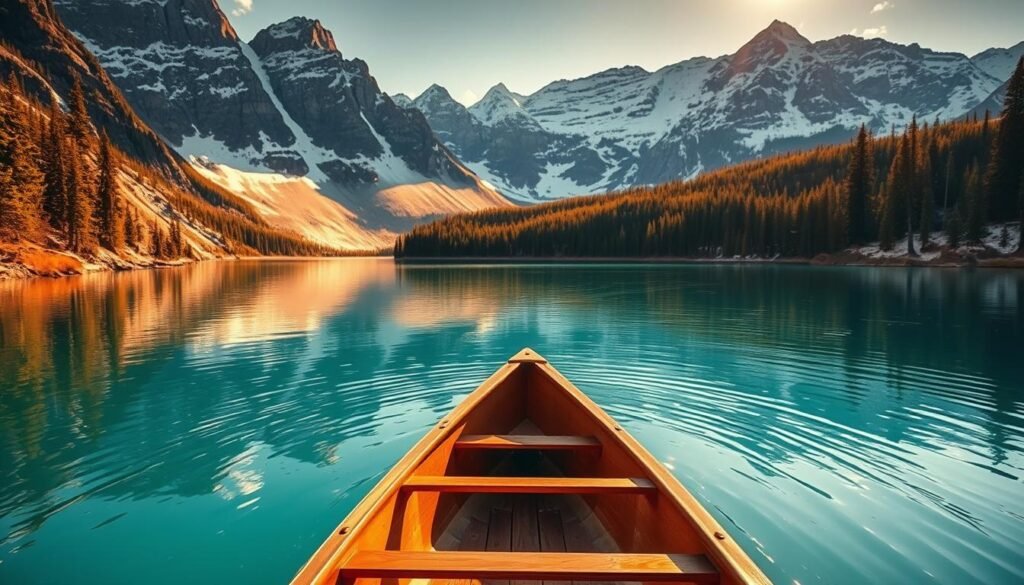
Each season brings a different set of must-do moments; I map which ones shine when. Below I list signature activities and practical tips so you can design days that flow—paddle in the morning, scenic drive midday, and a patio or gondola ride at sunset.
Summer classics
Lake Louise invites canoeing at dawn when the water turns turquoise and crowds are light. I suggest an early start for calm water and clearer photos.
Drive or tour the Icefields Parkway on a clear day for sweeping viewpoints. Leave early to avoid afternoon haze and busy pullouts.
Winter wonders
The Johnston Canyon ice walk is unforgettable—frozen waterfalls and carved ice corridors make for a lively hike. I recommend microspikes and checking conditions before you go.
The Banff Gondola brings holiday magic, lights, and town views. Combine a gondola ride with an evening stroll in town for a festive night out.
Shoulder season gems
Lake Minnewanka cruises run roughly May–October and offer relaxed lake access with fewer people. They’re a great swap if you want scenery without paddling effort.
Open Top Touring returns in mid-April; a guided loop gives context and history while avoiding peak summer traffic. Reserve spots for popular weekends.
| Season | Signature activity | Logistics tip |
|---|---|---|
| Summer | Canoe Lake Louise; Icefields Parkway viewpoints | Start early; pack sunscreen and water |
| Winter | Johnston Canyon ice walk; Banff Gondola holiday rides | Check trail reports; book gondola tickets in advance |
| Shoulder season | Lake Minnewanka cruise; Open Top Touring | Bring light layers; expect variable weather |
Lakes and paddling in the Canadian Rockies
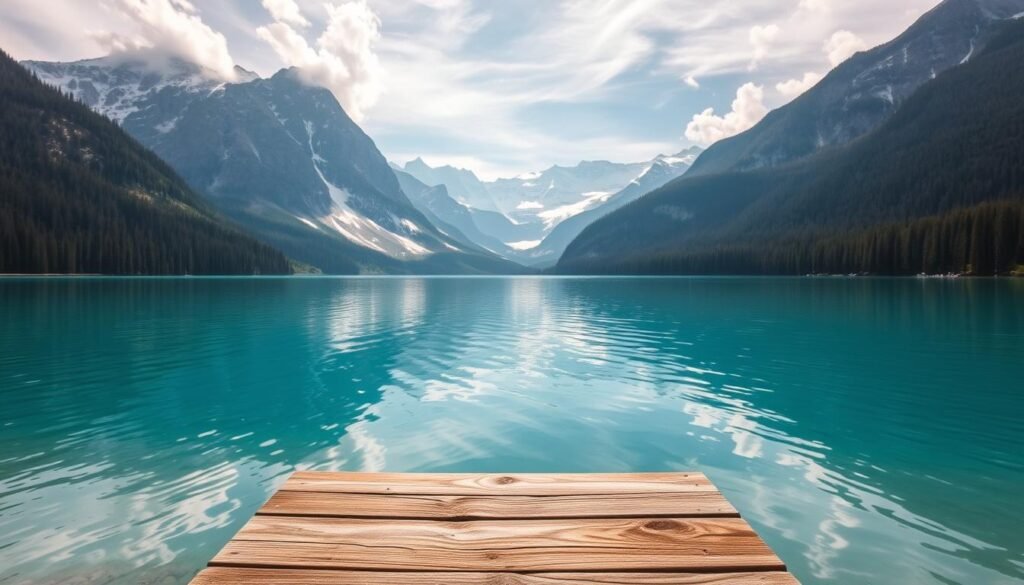
“A simple paddle can feel epic when the light, wind, and glacial silt line up.”
I watch how small changes in wind and light transform the lakes. Paddling season runs roughly April–October, with valley lakes opening in April–May and higher spots like Lake Louise often waiting until May or June.
When lakes thaw and glow
The unreal turquoise comes from glacial silt suspended in meltwater. Mid-to-late summer shows the strongest color as melt increases and waters calm.
Practical note: Mornings are best for reflections. Check wind and water conditions before you rent a canoe or kayak.
Frozen beauty
By late October the first freeze begins and by December most lakes hold firm ice. Lake Louise becomes a classic outdoor skating rink framed by mountains and quiet trails.
- I recommend planning paddles early or late in the day to avoid parking crush.
- Lake Minnewanka cruises run seasonally (commonly May–October) and are an easy way to get on the water.
- Respect cold water and sudden weather changes; wear layers and a personal flotation device.
For more planning tips, see my planning guide that covers seasonal conditions and logistics for lakes and trails.
Hiking, wildlife, and the golden larch trees
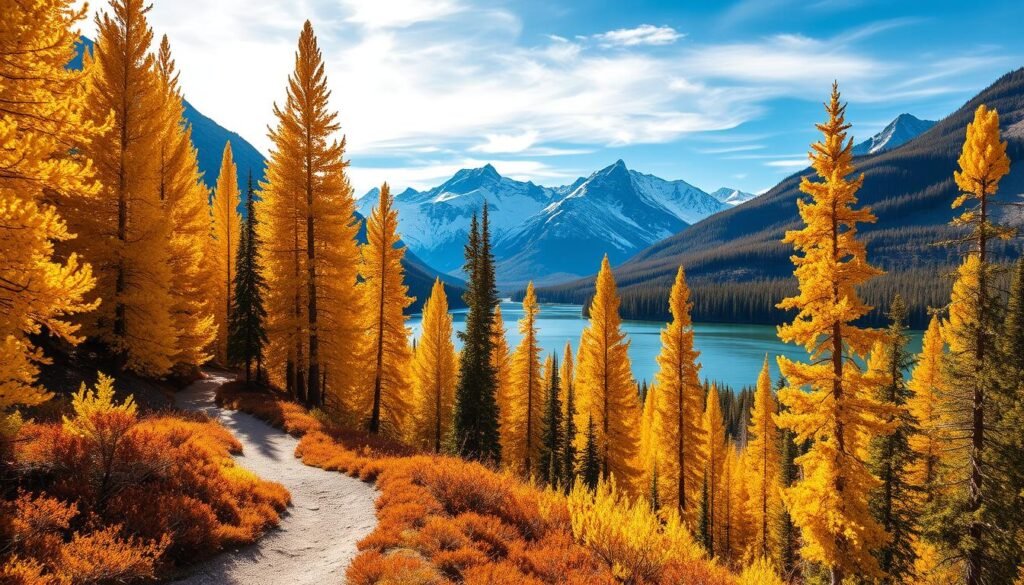
I match route choices to openings: lower routes often clear by April or May, while high passes usually wait until June and sometimes July. I plan mornings for quiet air and clearer light on peaks.
Windows for trail access
Lower trails commonly come into shape by April/May. High alpine routes hit prime between June and October.
Note: snow can linger—check current trail reports and carry traction gear if needed.
Wildlife safety and timing
I watch for wildlife at dawn and dusk year-round. The elk rut runs late August through mid-October and draws crowds; give animals space and avoid approaching.
Keep distance: 30 m for elk or deer and 100 m for bears and wolves. Carry bear spray and know how to use it.
Larch Madness
Larch trees flip gold from mid-September to late October. I plan subalpine hikes near Lake Louise or short shuttle routes to catch fall color without long scrambles.
- Pack layers—mountain weather changes fast within a single day.
- Choose early or late starts to avoid crowds and enjoy solitude on trails.
- Link a hike with a scenic drive or a lake stop for a full-day plan.
| Route type | When open | Tip |
|---|---|---|
| Low valley trails | Apr–May onward | Good for early-season hiking |
| High passes | Jun–Oct | Check snow and start early |
| Shuttle-access | Seasonal | Great for non-hikers to see larch |
Leave No Trace: protect wildlife, trees, and fragile alpine areas—pack out trash, stay on trails, and never feed animals. This keeps the national park special for everyone and helps when you visit banff again.
Weather, crowds, and prices: How timing affects your trip
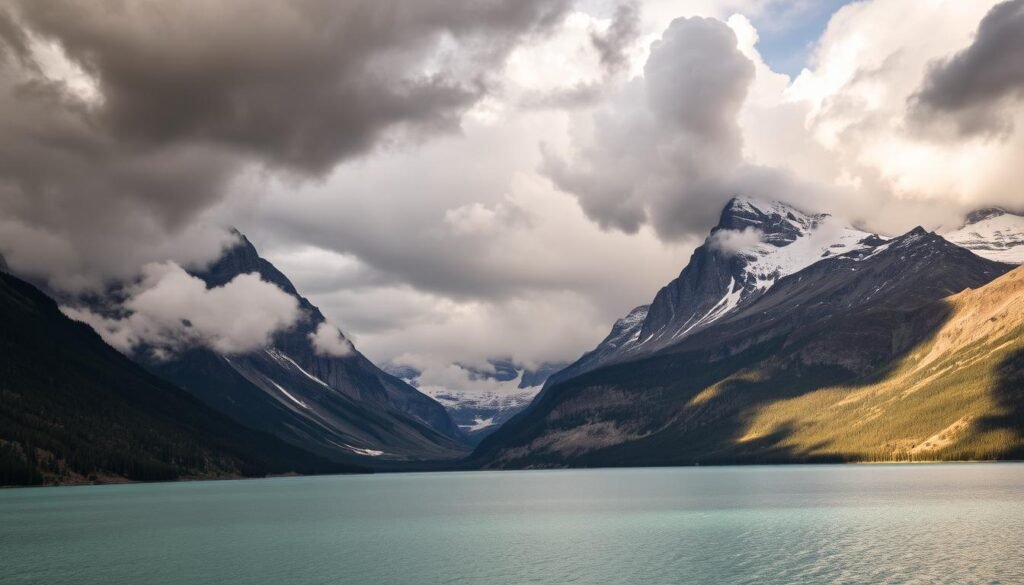
I compare weather patterns, crowd shifts, and price swings so you can pick the season that fits your goals.
Temperatures and daylight by season
January is the coldest month with fewer than nine hours of daylight, and February offers about ten hours mid-month. July averages roughly 72°F and is the sunniest, while August sits near 71°F.
September cools to about 63°F; October drops near 50°F; November averages around 37°F. June often brings the most rain, so pack a shell.
Peak vs. shoulder seasons: Costs, availability, and road/tour openings
Peak months (July–August and December–March) give full access, long days in summer, and many events. Expect higher prices and fuller parking.
Shoulder season (May, early June, September, November) trades a few closures for space and savings. May and September often deliver lower rates while keeping access high.
- I recommend layers for quick swings in temperature and traction for icy mornings.
- Start early in winter when days are short; enjoy long summer evenings in July.
- Some tours pause in April; the Columbia Icefield Adventure reopens in May and Lake Minnewanka cruises run seasonally.
- Deep winter can close roads—check current conditions and live forecasts before you head out.
| Season | Typical temperatures | Daylight and access | Cost & crowds |
|---|---|---|---|
| Winter (Jan–Feb) | Cold; Jan coldest | High for holidays; fewer midweek crowds | |
| Summer (Jul–Aug) | ~71–72°F; sunniest | Long days; full access to trails | Peak pricing; busy parking and lakes |
| Shoulder (May, Sep) | Cool mornings; mild afternoons | Good access; fewer visitors | Lower rates; some tour gaps |
| June | Mild; often wet | Variable; higher trails open gradually | Mixed—book popular tours early |
Quick planning rule: if you want value, aim for shoulder months; if you need full event access, book peak months well in advance. Remember elevation affects temperature—higher spots stay colder and may hold snow into early summer.
Best time to visit Banff for your favorite activities
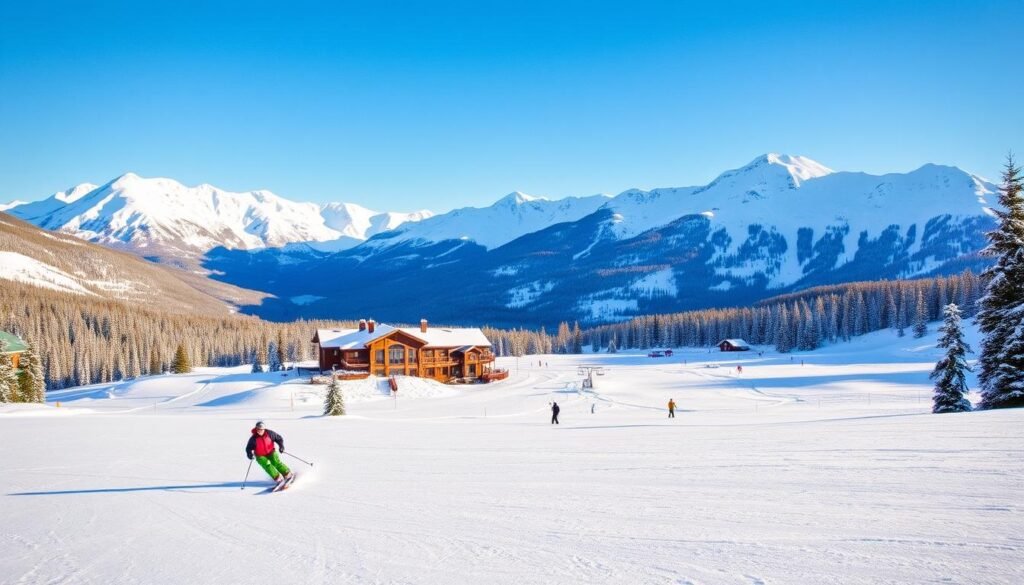
Different goals need different windows. I match activities with months so you can plan around powder, color, or festivals without guesswork.
Skiing and snowboarding
Ski season runs November–May, and March often hits the sweet spot: reliable snow, longer daylight, and milder temps. Early-season dumps in November kick off winter stoke, while April offers softer turns under spring sun.
Photography windows
I plan shoots by subject. Milky Way alignments happen in clear summer nights; larch gold peaks mid-September through late October. In deep winter, methane bubbles and ice patterns create unique frames—check local astronomy and trail calendars before you go.
Events and festivals
SnowDays shows up in January and Ice Magic runs at Lake Louise. Fall brings the Banff Centre film and book festival, and food and wine weekends spread across the season. For a festive evening, I pair a twilight banff gondola ride with town lights.You can learn more about best-time-to-visit-london.
| Activity | Window | Quick tip |
|---|---|---|
| Skiing | Nov–May (March ideal) | Book lift passes early; aim midweek |
| Photography | Summer nights; Sep–Oct for larch; winter for ice | Scout locations at dawn; join guided night sessions |
| Festivals & events | Jan, Sep–Nov, seasonal weekends | Arrive early; reserve tickets ahead |
| Trails & hikes | Groomed winter trails; high passes late summer | Carry traction in winter; start early in shoulder months |
Planning checklist: pack layers and traction gear for snow and ice, reserve gondola slots, and book guided photo or ski sessions if you want expert timing. Match your priority with the right week and you’ll get more out of visiting banff.
Conclusion
,To finish, I offer a compact plan that matches weather, crowds, and activities with your goals.
Quick summary: May, June, and September balance warm weather, open lakes, and lighter crowds. For reliable snow and longer daylight on slopes, aim for March.
I recommend shoulder months for quieter trails, easier parking, and better hotel value with minor trade-offs in higher-elevation access. Don’t miss Lake Louise in summer or winter, Johnston Canyon’s ice, and the golden larch weeks.
Final checklist: check current forecasts, pack layers and traction, book key tours early, and consider midweek arrivals for calmer town moments. Every year shifts a bit—stay flexible and you’ll get the experience you want.
I’ve given the facts; now pick your window, plan routes and trails, and enjoy visiting banff national park.


